A Comprehensive Analysis of London's Economic Evolution and Policy
VerifiedAdded on 2023/06/13
|13
|3151
|196
Essay
AI Summary
This essay provides a comprehensive analysis of the economic evolution of London over the past two decades, examining key economic indicators such as Gross Value Added (GVA) and employment trends. It highlights London's significant contribution to the UK's GDP and its superior economic performance compared to other UK cities. The essay explores the reasons behind London's growth, including its diverse population, inflow of immigrants, and effective policy frameworks. It also discusses the implications of national and local policies, particularly the London Plan, on the city's economic development. The analysis includes comparative data and figures to illustrate the growth patterns and the impact of economic events like the Global Financial Crisis, emphasizing London's resilience and adaptability in maintaining a robust and evolving economy.

Running head: ECONOMIC EVOLUTION OF LONDON
Economic Evolution of London
Name of the Student
Name of the University
Author Note
Economic Evolution of London
Name of the Student
Name of the University
Author Note
Secure Best Marks with AI Grader
Need help grading? Try our AI Grader for instant feedback on your assignments.
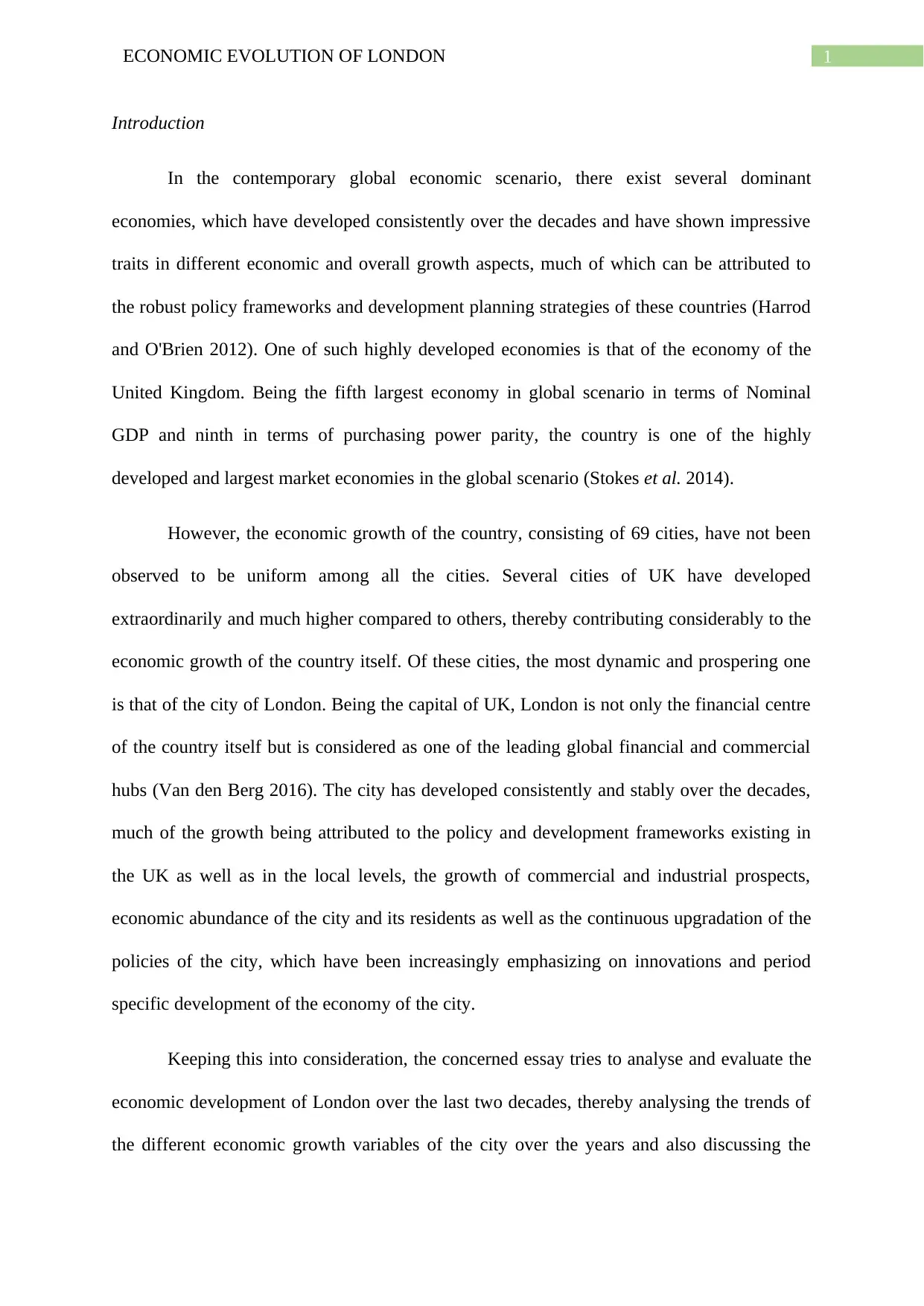
1ECONOMIC EVOLUTION OF LONDON
Introduction
In the contemporary global economic scenario, there exist several dominant
economies, which have developed consistently over the decades and have shown impressive
traits in different economic and overall growth aspects, much of which can be attributed to
the robust policy frameworks and development planning strategies of these countries (Harrod
and O'Brien 2012). One of such highly developed economies is that of the economy of the
United Kingdom. Being the fifth largest economy in global scenario in terms of Nominal
GDP and ninth in terms of purchasing power parity, the country is one of the highly
developed and largest market economies in the global scenario (Stokes et al. 2014).
However, the economic growth of the country, consisting of 69 cities, have not been
observed to be uniform among all the cities. Several cities of UK have developed
extraordinarily and much higher compared to others, thereby contributing considerably to the
economic growth of the country itself. Of these cities, the most dynamic and prospering one
is that of the city of London. Being the capital of UK, London is not only the financial centre
of the country itself but is considered as one of the leading global financial and commercial
hubs (Van den Berg 2016). The city has developed consistently and stably over the decades,
much of the growth being attributed to the policy and development frameworks existing in
the UK as well as in the local levels, the growth of commercial and industrial prospects,
economic abundance of the city and its residents as well as the continuous upgradation of the
policies of the city, which have been increasingly emphasizing on innovations and period
specific development of the economy of the city.
Keeping this into consideration, the concerned essay tries to analyse and evaluate the
economic development of London over the last two decades, thereby analysing the trends of
the different economic growth variables of the city over the years and also discussing the
Introduction
In the contemporary global economic scenario, there exist several dominant
economies, which have developed consistently over the decades and have shown impressive
traits in different economic and overall growth aspects, much of which can be attributed to
the robust policy frameworks and development planning strategies of these countries (Harrod
and O'Brien 2012). One of such highly developed economies is that of the economy of the
United Kingdom. Being the fifth largest economy in global scenario in terms of Nominal
GDP and ninth in terms of purchasing power parity, the country is one of the highly
developed and largest market economies in the global scenario (Stokes et al. 2014).
However, the economic growth of the country, consisting of 69 cities, have not been
observed to be uniform among all the cities. Several cities of UK have developed
extraordinarily and much higher compared to others, thereby contributing considerably to the
economic growth of the country itself. Of these cities, the most dynamic and prospering one
is that of the city of London. Being the capital of UK, London is not only the financial centre
of the country itself but is considered as one of the leading global financial and commercial
hubs (Van den Berg 2016). The city has developed consistently and stably over the decades,
much of the growth being attributed to the policy and development frameworks existing in
the UK as well as in the local levels, the growth of commercial and industrial prospects,
economic abundance of the city and its residents as well as the continuous upgradation of the
policies of the city, which have been increasingly emphasizing on innovations and period
specific development of the economy of the city.
Keeping this into consideration, the concerned essay tries to analyse and evaluate the
economic development of London over the last two decades, thereby analysing the trends of
the different economic growth variables of the city over the years and also discussing the
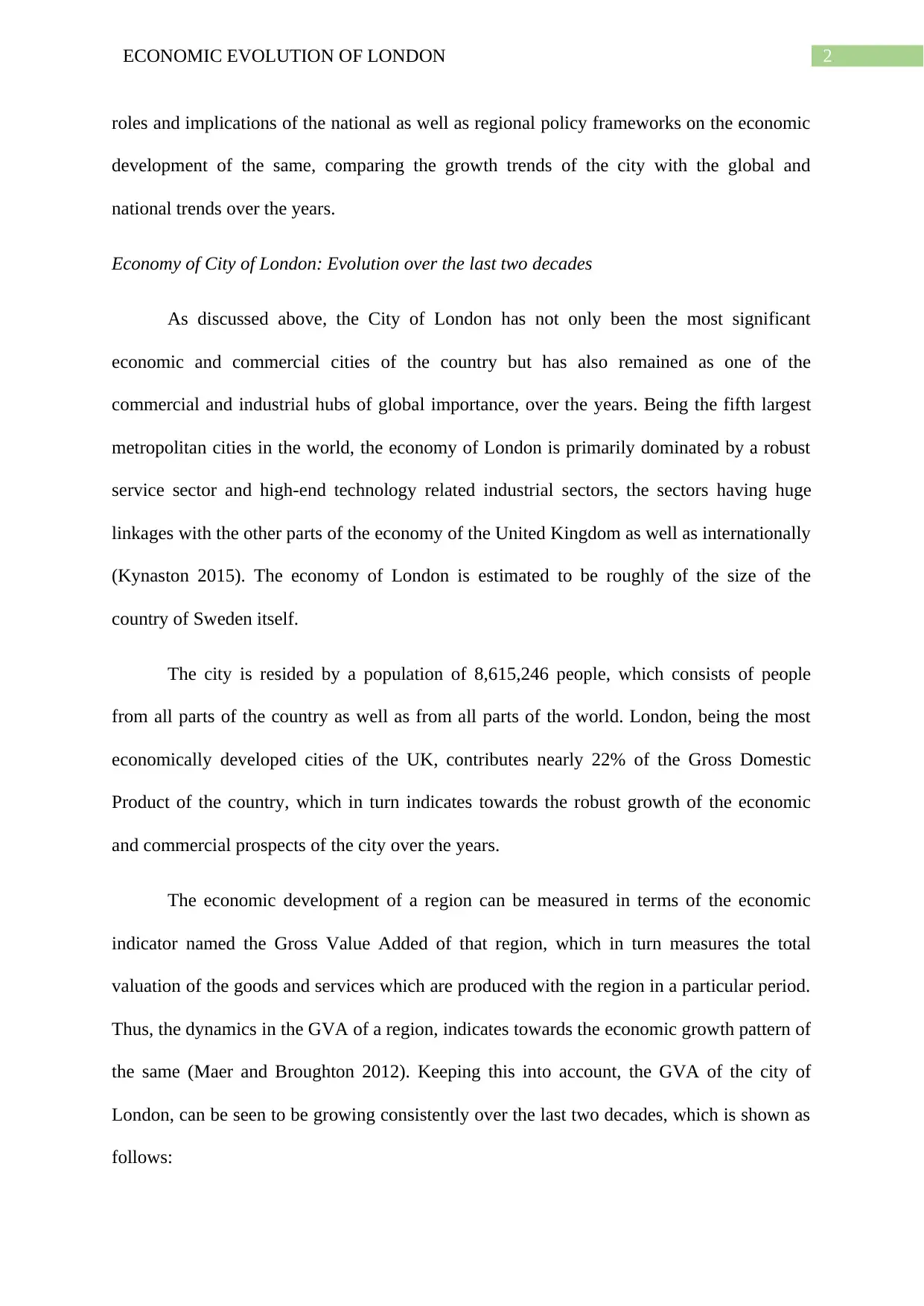
2ECONOMIC EVOLUTION OF LONDON
roles and implications of the national as well as regional policy frameworks on the economic
development of the same, comparing the growth trends of the city with the global and
national trends over the years.
Economy of City of London: Evolution over the last two decades
As discussed above, the City of London has not only been the most significant
economic and commercial cities of the country but has also remained as one of the
commercial and industrial hubs of global importance, over the years. Being the fifth largest
metropolitan cities in the world, the economy of London is primarily dominated by a robust
service sector and high-end technology related industrial sectors, the sectors having huge
linkages with the other parts of the economy of the United Kingdom as well as internationally
(Kynaston 2015). The economy of London is estimated to be roughly of the size of the
country of Sweden itself.
The city is resided by a population of 8,615,246 people, which consists of people
from all parts of the country as well as from all parts of the world. London, being the most
economically developed cities of the UK, contributes nearly 22% of the Gross Domestic
Product of the country, which in turn indicates towards the robust growth of the economic
and commercial prospects of the city over the years.
The economic development of a region can be measured in terms of the economic
indicator named the Gross Value Added of that region, which in turn measures the total
valuation of the goods and services which are produced with the region in a particular period.
Thus, the dynamics in the GVA of a region, indicates towards the economic growth pattern of
the same (Maer and Broughton 2012). Keeping this into account, the GVA of the city of
London, can be seen to be growing consistently over the last two decades, which is shown as
follows:
roles and implications of the national as well as regional policy frameworks on the economic
development of the same, comparing the growth trends of the city with the global and
national trends over the years.
Economy of City of London: Evolution over the last two decades
As discussed above, the City of London has not only been the most significant
economic and commercial cities of the country but has also remained as one of the
commercial and industrial hubs of global importance, over the years. Being the fifth largest
metropolitan cities in the world, the economy of London is primarily dominated by a robust
service sector and high-end technology related industrial sectors, the sectors having huge
linkages with the other parts of the economy of the United Kingdom as well as internationally
(Kynaston 2015). The economy of London is estimated to be roughly of the size of the
country of Sweden itself.
The city is resided by a population of 8,615,246 people, which consists of people
from all parts of the country as well as from all parts of the world. London, being the most
economically developed cities of the UK, contributes nearly 22% of the Gross Domestic
Product of the country, which in turn indicates towards the robust growth of the economic
and commercial prospects of the city over the years.
The economic development of a region can be measured in terms of the economic
indicator named the Gross Value Added of that region, which in turn measures the total
valuation of the goods and services which are produced with the region in a particular period.
Thus, the dynamics in the GVA of a region, indicates towards the economic growth pattern of
the same (Maer and Broughton 2012). Keeping this into account, the GVA of the city of
London, can be seen to be growing consistently over the last two decades, which is shown as
follows:
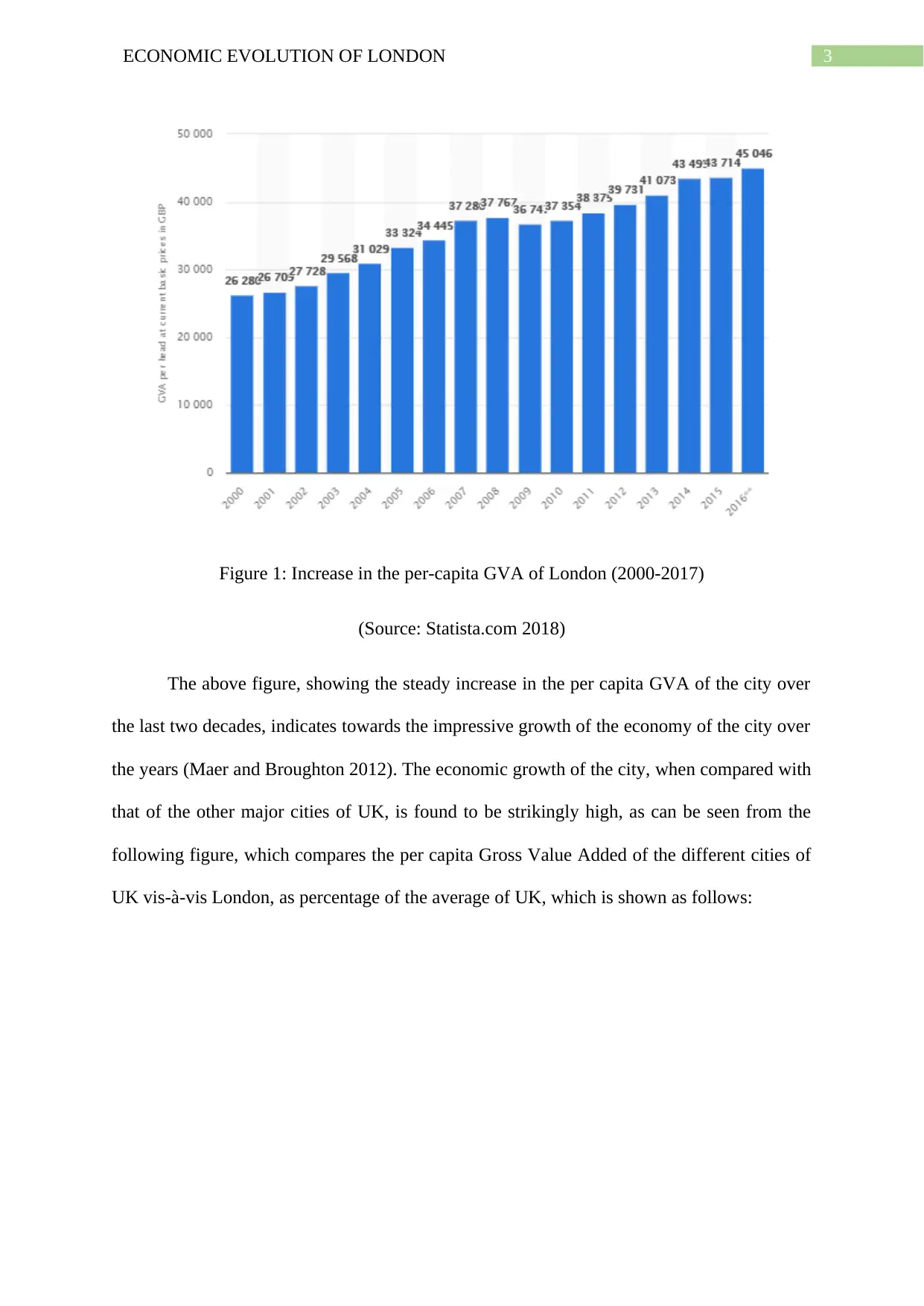
3ECONOMIC EVOLUTION OF LONDON
Figure 1: Increase in the per-capita GVA of London (2000-2017)
(Source: Statista.com 2018)
The above figure, showing the steady increase in the per capita GVA of the city over
the last two decades, indicates towards the impressive growth of the economy of the city over
the years (Maer and Broughton 2012). The economic growth of the city, when compared with
that of the other major cities of UK, is found to be strikingly high, as can be seen from the
following figure, which compares the per capita Gross Value Added of the different cities of
UK vis-à-vis London, as percentage of the average of UK, which is shown as follows:
Figure 1: Increase in the per-capita GVA of London (2000-2017)
(Source: Statista.com 2018)
The above figure, showing the steady increase in the per capita GVA of the city over
the last two decades, indicates towards the impressive growth of the economy of the city over
the years (Maer and Broughton 2012). The economic growth of the city, when compared with
that of the other major cities of UK, is found to be strikingly high, as can be seen from the
following figure, which compares the per capita Gross Value Added of the different cities of
UK vis-à-vis London, as percentage of the average of UK, which is shown as follows:
Secure Best Marks with AI Grader
Need help grading? Try our AI Grader for instant feedback on your assignments.
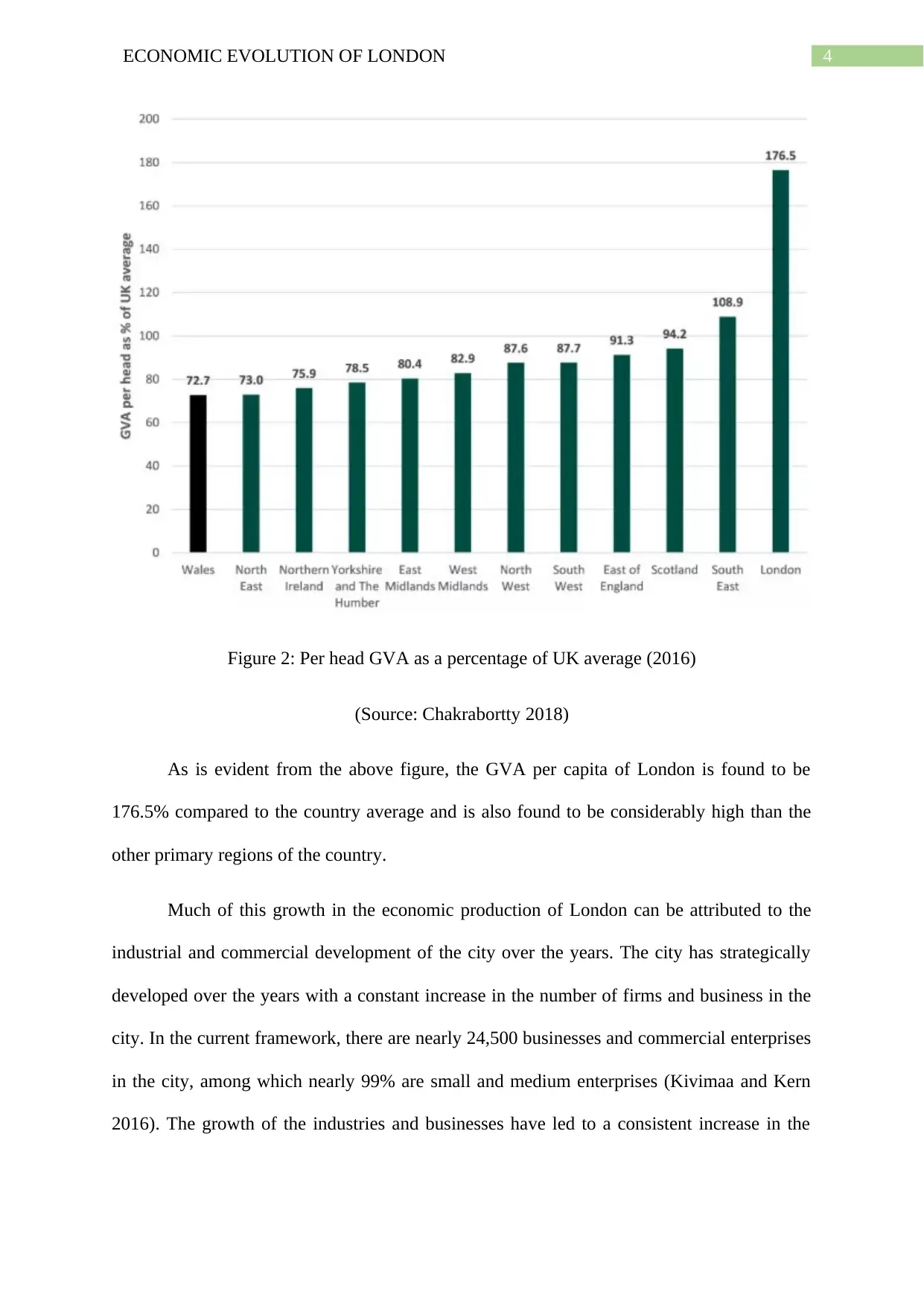
4ECONOMIC EVOLUTION OF LONDON
Figure 2: Per head GVA as a percentage of UK average (2016)
(Source: Chakrabortty 2018)
As is evident from the above figure, the GVA per capita of London is found to be
176.5% compared to the country average and is also found to be considerably high than the
other primary regions of the country.
Much of this growth in the economic production of London can be attributed to the
industrial and commercial development of the city over the years. The city has strategically
developed over the years with a constant increase in the number of firms and business in the
city. In the current framework, there are nearly 24,500 businesses and commercial enterprises
in the city, among which nearly 99% are small and medium enterprises (Kivimaa and Kern
2016). The growth of the industries and businesses have led to a consistent increase in the
Figure 2: Per head GVA as a percentage of UK average (2016)
(Source: Chakrabortty 2018)
As is evident from the above figure, the GVA per capita of London is found to be
176.5% compared to the country average and is also found to be considerably high than the
other primary regions of the country.
Much of this growth in the economic production of London can be attributed to the
industrial and commercial development of the city over the years. The city has strategically
developed over the years with a constant increase in the number of firms and business in the
city. In the current framework, there are nearly 24,500 businesses and commercial enterprises
in the city, among which nearly 99% are small and medium enterprises (Kivimaa and Kern
2016). The growth of the industries and businesses have led to a consistent increase in the
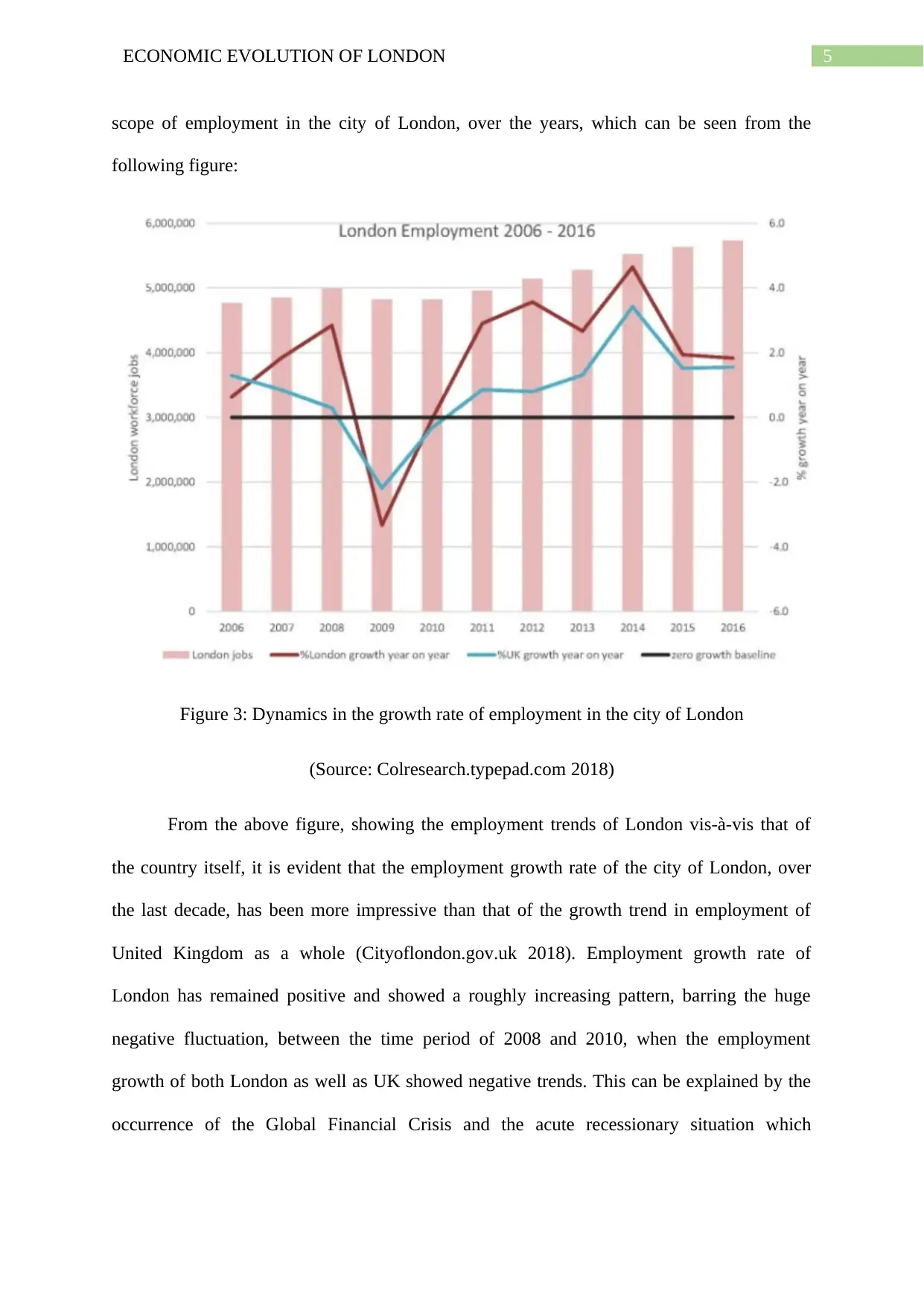
5ECONOMIC EVOLUTION OF LONDON
scope of employment in the city of London, over the years, which can be seen from the
following figure:
Figure 3: Dynamics in the growth rate of employment in the city of London
(Source: Colresearch.typepad.com 2018)
From the above figure, showing the employment trends of London vis-à-vis that of
the country itself, it is evident that the employment growth rate of the city of London, over
the last decade, has been more impressive than that of the growth trend in employment of
United Kingdom as a whole (Cityoflondon.gov.uk 2018). Employment growth rate of
London has remained positive and showed a roughly increasing pattern, barring the huge
negative fluctuation, between the time period of 2008 and 2010, when the employment
growth of both London as well as UK showed negative trends. This can be explained by the
occurrence of the Global Financial Crisis and the acute recessionary situation which
scope of employment in the city of London, over the years, which can be seen from the
following figure:
Figure 3: Dynamics in the growth rate of employment in the city of London
(Source: Colresearch.typepad.com 2018)
From the above figure, showing the employment trends of London vis-à-vis that of
the country itself, it is evident that the employment growth rate of the city of London, over
the last decade, has been more impressive than that of the growth trend in employment of
United Kingdom as a whole (Cityoflondon.gov.uk 2018). Employment growth rate of
London has remained positive and showed a roughly increasing pattern, barring the huge
negative fluctuation, between the time period of 2008 and 2010, when the employment
growth of both London as well as UK showed negative trends. This can be explained by the
occurrence of the Global Financial Crisis and the acute recessionary situation which
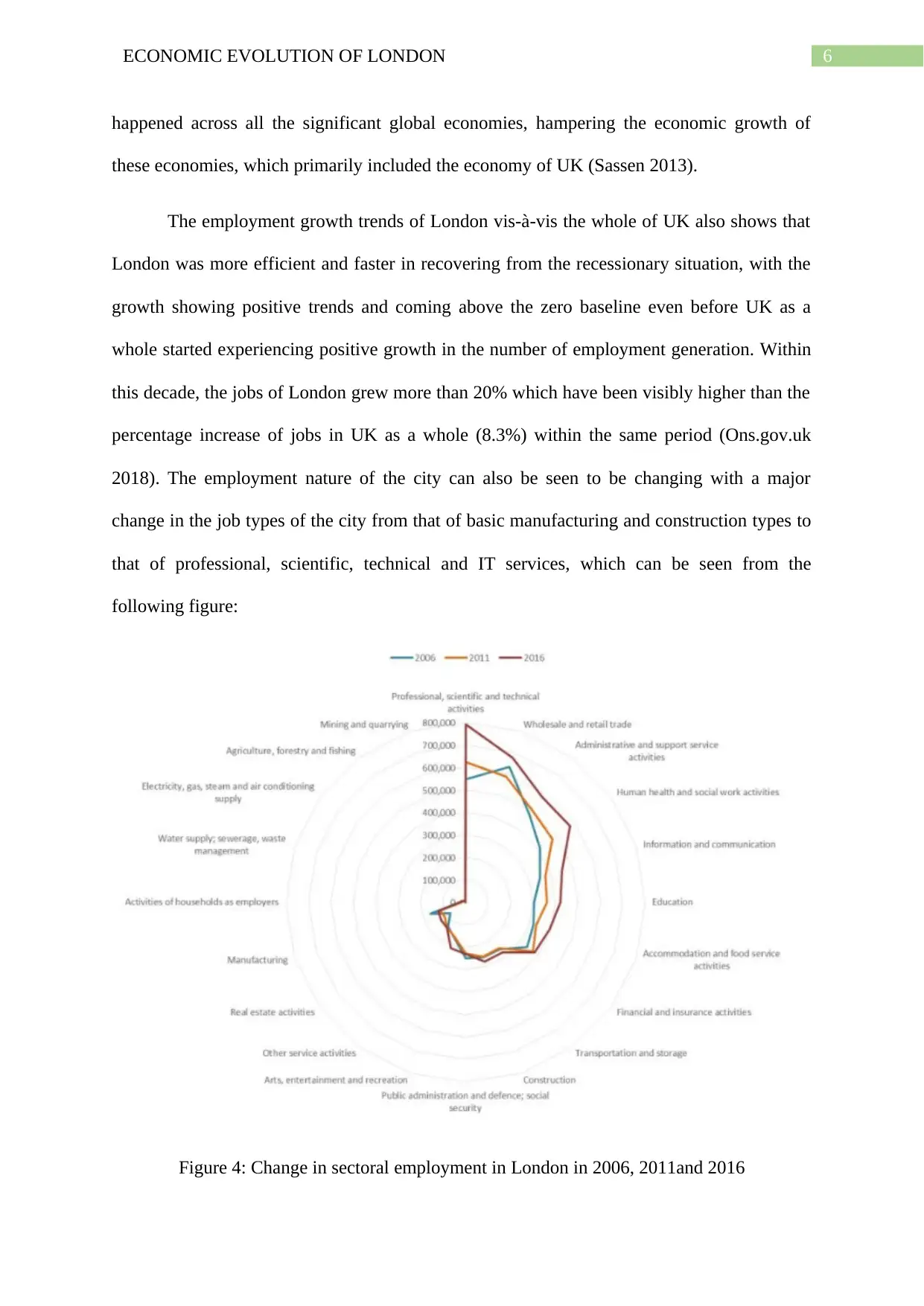
6ECONOMIC EVOLUTION OF LONDON
happened across all the significant global economies, hampering the economic growth of
these economies, which primarily included the economy of UK (Sassen 2013).
The employment growth trends of London vis-à-vis the whole of UK also shows that
London was more efficient and faster in recovering from the recessionary situation, with the
growth showing positive trends and coming above the zero baseline even before UK as a
whole started experiencing positive growth in the number of employment generation. Within
this decade, the jobs of London grew more than 20% which have been visibly higher than the
percentage increase of jobs in UK as a whole (8.3%) within the same period (Ons.gov.uk
2018). The employment nature of the city can also be seen to be changing with a major
change in the job types of the city from that of basic manufacturing and construction types to
that of professional, scientific, technical and IT services, which can be seen from the
following figure:
Figure 4: Change in sectoral employment in London in 2006, 2011and 2016
happened across all the significant global economies, hampering the economic growth of
these economies, which primarily included the economy of UK (Sassen 2013).
The employment growth trends of London vis-à-vis the whole of UK also shows that
London was more efficient and faster in recovering from the recessionary situation, with the
growth showing positive trends and coming above the zero baseline even before UK as a
whole started experiencing positive growth in the number of employment generation. Within
this decade, the jobs of London grew more than 20% which have been visibly higher than the
percentage increase of jobs in UK as a whole (8.3%) within the same period (Ons.gov.uk
2018). The employment nature of the city can also be seen to be changing with a major
change in the job types of the city from that of basic manufacturing and construction types to
that of professional, scientific, technical and IT services, which can be seen from the
following figure:
Figure 4: Change in sectoral employment in London in 2006, 2011and 2016
Paraphrase This Document
Need a fresh take? Get an instant paraphrase of this document with our AI Paraphraser
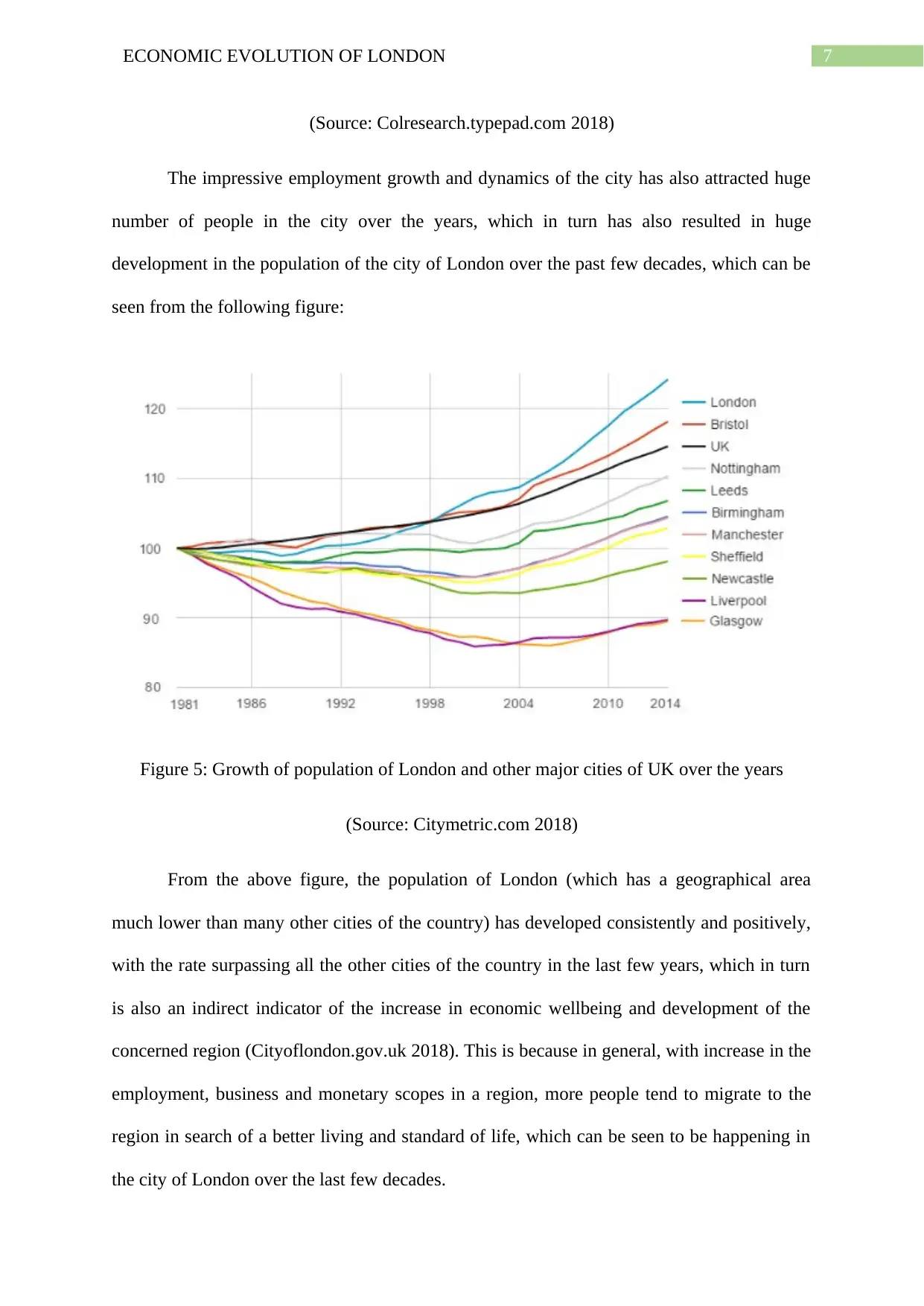
7ECONOMIC EVOLUTION OF LONDON
(Source: Colresearch.typepad.com 2018)
The impressive employment growth and dynamics of the city has also attracted huge
number of people in the city over the years, which in turn has also resulted in huge
development in the population of the city of London over the past few decades, which can be
seen from the following figure:
Figure 5: Growth of population of London and other major cities of UK over the years
(Source: Citymetric.com 2018)
From the above figure, the population of London (which has a geographical area
much lower than many other cities of the country) has developed consistently and positively,
with the rate surpassing all the other cities of the country in the last few years, which in turn
is also an indirect indicator of the increase in economic wellbeing and development of the
concerned region (Cityoflondon.gov.uk 2018). This is because in general, with increase in the
employment, business and monetary scopes in a region, more people tend to migrate to the
region in search of a better living and standard of life, which can be seen to be happening in
the city of London over the last few decades.
(Source: Colresearch.typepad.com 2018)
The impressive employment growth and dynamics of the city has also attracted huge
number of people in the city over the years, which in turn has also resulted in huge
development in the population of the city of London over the past few decades, which can be
seen from the following figure:
Figure 5: Growth of population of London and other major cities of UK over the years
(Source: Citymetric.com 2018)
From the above figure, the population of London (which has a geographical area
much lower than many other cities of the country) has developed consistently and positively,
with the rate surpassing all the other cities of the country in the last few years, which in turn
is also an indirect indicator of the increase in economic wellbeing and development of the
concerned region (Cityoflondon.gov.uk 2018). This is because in general, with increase in the
employment, business and monetary scopes in a region, more people tend to migrate to the
region in search of a better living and standard of life, which can be seen to be happening in
the city of London over the last few decades.
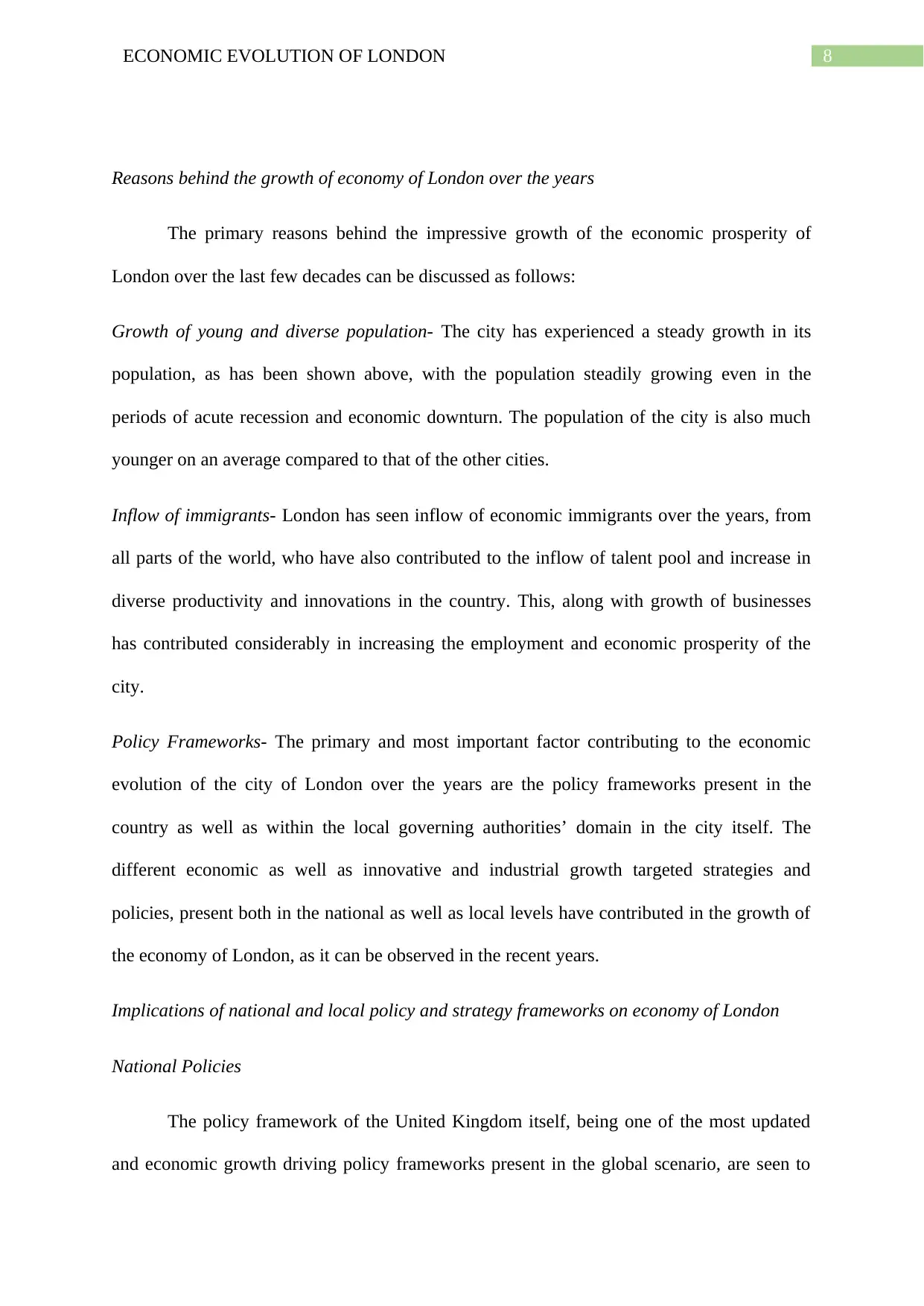
8ECONOMIC EVOLUTION OF LONDON
Reasons behind the growth of economy of London over the years
The primary reasons behind the impressive growth of the economic prosperity of
London over the last few decades can be discussed as follows:
Growth of young and diverse population- The city has experienced a steady growth in its
population, as has been shown above, with the population steadily growing even in the
periods of acute recession and economic downturn. The population of the city is also much
younger on an average compared to that of the other cities.
Inflow of immigrants- London has seen inflow of economic immigrants over the years, from
all parts of the world, who have also contributed to the inflow of talent pool and increase in
diverse productivity and innovations in the country. This, along with growth of businesses
has contributed considerably in increasing the employment and economic prosperity of the
city.
Policy Frameworks- The primary and most important factor contributing to the economic
evolution of the city of London over the years are the policy frameworks present in the
country as well as within the local governing authorities’ domain in the city itself. The
different economic as well as innovative and industrial growth targeted strategies and
policies, present both in the national as well as local levels have contributed in the growth of
the economy of London, as it can be observed in the recent years.
Implications of national and local policy and strategy frameworks on economy of London
National Policies
The policy framework of the United Kingdom itself, being one of the most updated
and economic growth driving policy frameworks present in the global scenario, are seen to
Reasons behind the growth of economy of London over the years
The primary reasons behind the impressive growth of the economic prosperity of
London over the last few decades can be discussed as follows:
Growth of young and diverse population- The city has experienced a steady growth in its
population, as has been shown above, with the population steadily growing even in the
periods of acute recession and economic downturn. The population of the city is also much
younger on an average compared to that of the other cities.
Inflow of immigrants- London has seen inflow of economic immigrants over the years, from
all parts of the world, who have also contributed to the inflow of talent pool and increase in
diverse productivity and innovations in the country. This, along with growth of businesses
has contributed considerably in increasing the employment and economic prosperity of the
city.
Policy Frameworks- The primary and most important factor contributing to the economic
evolution of the city of London over the years are the policy frameworks present in the
country as well as within the local governing authorities’ domain in the city itself. The
different economic as well as innovative and industrial growth targeted strategies and
policies, present both in the national as well as local levels have contributed in the growth of
the economy of London, as it can be observed in the recent years.
Implications of national and local policy and strategy frameworks on economy of London
National Policies
The policy framework of the United Kingdom itself, being one of the most updated
and economic growth driving policy frameworks present in the global scenario, are seen to
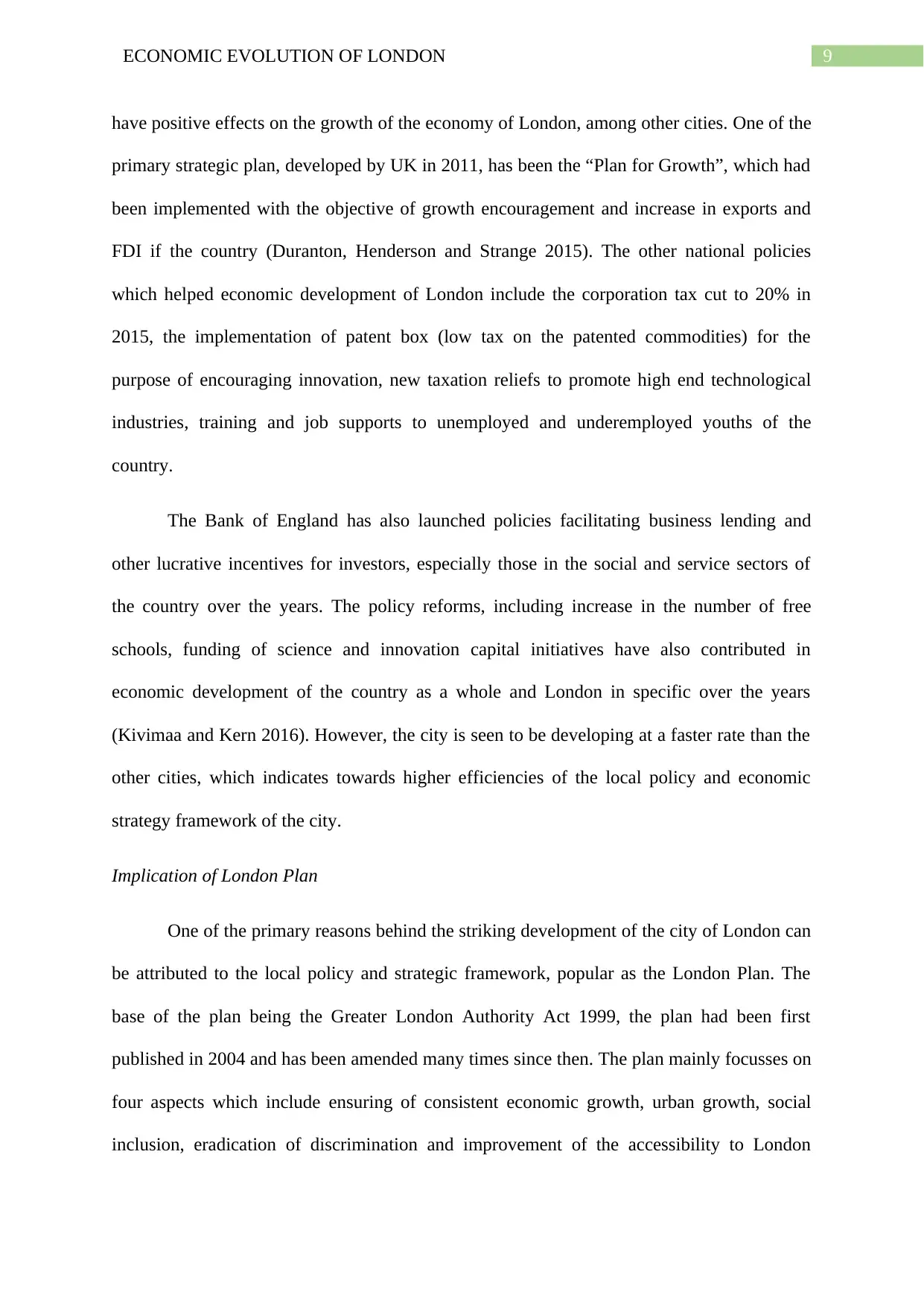
9ECONOMIC EVOLUTION OF LONDON
have positive effects on the growth of the economy of London, among other cities. One of the
primary strategic plan, developed by UK in 2011, has been the “Plan for Growth”, which had
been implemented with the objective of growth encouragement and increase in exports and
FDI if the country (Duranton, Henderson and Strange 2015). The other national policies
which helped economic development of London include the corporation tax cut to 20% in
2015, the implementation of patent box (low tax on the patented commodities) for the
purpose of encouraging innovation, new taxation reliefs to promote high end technological
industries, training and job supports to unemployed and underemployed youths of the
country.
The Bank of England has also launched policies facilitating business lending and
other lucrative incentives for investors, especially those in the social and service sectors of
the country over the years. The policy reforms, including increase in the number of free
schools, funding of science and innovation capital initiatives have also contributed in
economic development of the country as a whole and London in specific over the years
(Kivimaa and Kern 2016). However, the city is seen to be developing at a faster rate than the
other cities, which indicates towards higher efficiencies of the local policy and economic
strategy framework of the city.
Implication of London Plan
One of the primary reasons behind the striking development of the city of London can
be attributed to the local policy and strategic framework, popular as the London Plan. The
base of the plan being the Greater London Authority Act 1999, the plan had been first
published in 2004 and has been amended many times since then. The plan mainly focusses on
four aspects which include ensuring of consistent economic growth, urban growth, social
inclusion, eradication of discrimination and improvement of the accessibility to London
have positive effects on the growth of the economy of London, among other cities. One of the
primary strategic plan, developed by UK in 2011, has been the “Plan for Growth”, which had
been implemented with the objective of growth encouragement and increase in exports and
FDI if the country (Duranton, Henderson and Strange 2015). The other national policies
which helped economic development of London include the corporation tax cut to 20% in
2015, the implementation of patent box (low tax on the patented commodities) for the
purpose of encouraging innovation, new taxation reliefs to promote high end technological
industries, training and job supports to unemployed and underemployed youths of the
country.
The Bank of England has also launched policies facilitating business lending and
other lucrative incentives for investors, especially those in the social and service sectors of
the country over the years. The policy reforms, including increase in the number of free
schools, funding of science and innovation capital initiatives have also contributed in
economic development of the country as a whole and London in specific over the years
(Kivimaa and Kern 2016). However, the city is seen to be developing at a faster rate than the
other cities, which indicates towards higher efficiencies of the local policy and economic
strategy framework of the city.
Implication of London Plan
One of the primary reasons behind the striking development of the city of London can
be attributed to the local policy and strategic framework, popular as the London Plan. The
base of the plan being the Greater London Authority Act 1999, the plan had been first
published in 2004 and has been amended many times since then. The plan mainly focusses on
four aspects which include ensuring of consistent economic growth, urban growth, social
inclusion, eradication of discrimination and improvement of the accessibility to London
Secure Best Marks with AI Grader
Need help grading? Try our AI Grader for instant feedback on your assignments.
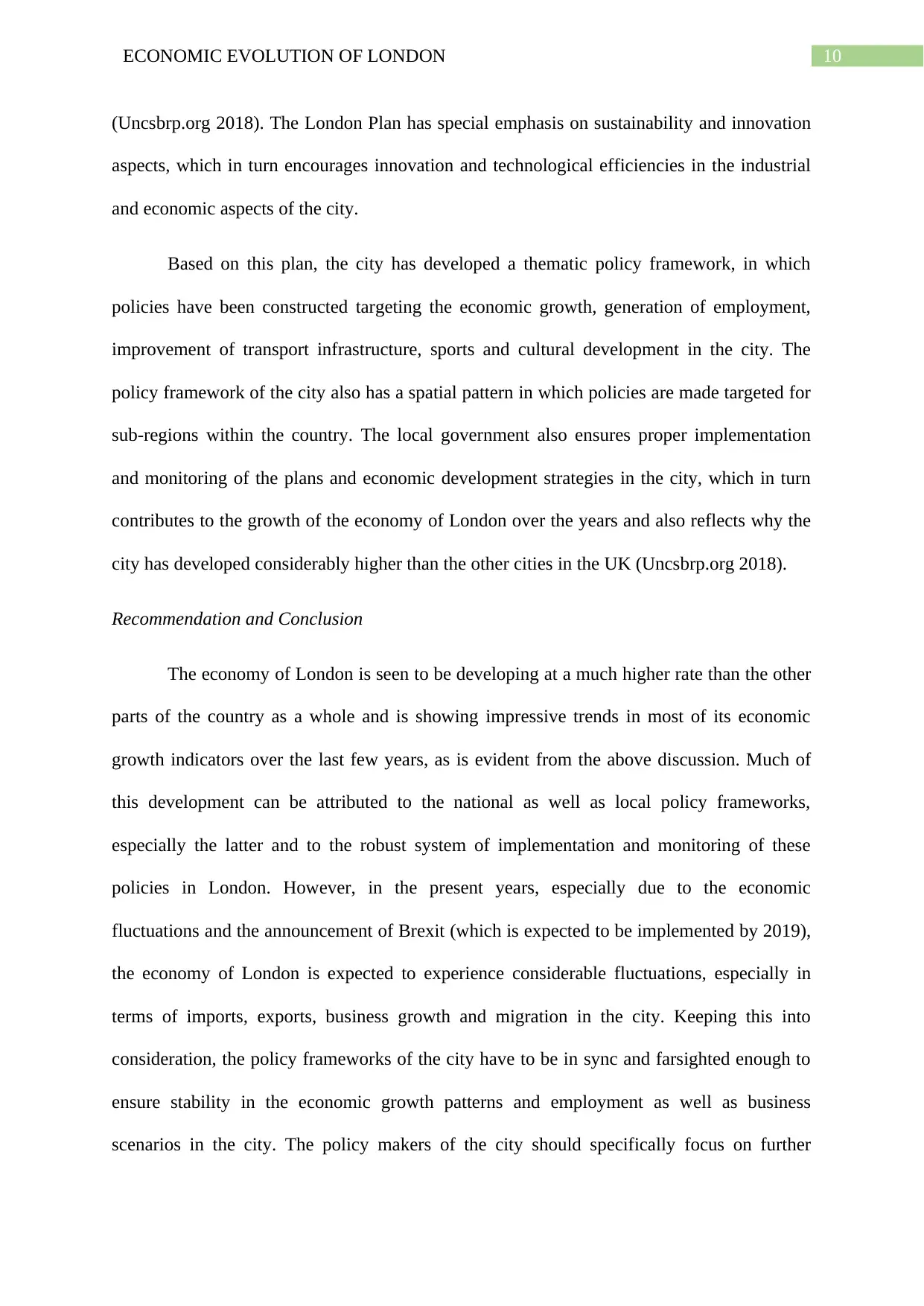
10ECONOMIC EVOLUTION OF LONDON
(Uncsbrp.org 2018). The London Plan has special emphasis on sustainability and innovation
aspects, which in turn encourages innovation and technological efficiencies in the industrial
and economic aspects of the city.
Based on this plan, the city has developed a thematic policy framework, in which
policies have been constructed targeting the economic growth, generation of employment,
improvement of transport infrastructure, sports and cultural development in the city. The
policy framework of the city also has a spatial pattern in which policies are made targeted for
sub-regions within the country. The local government also ensures proper implementation
and monitoring of the plans and economic development strategies in the city, which in turn
contributes to the growth of the economy of London over the years and also reflects why the
city has developed considerably higher than the other cities in the UK (Uncsbrp.org 2018).
Recommendation and Conclusion
The economy of London is seen to be developing at a much higher rate than the other
parts of the country as a whole and is showing impressive trends in most of its economic
growth indicators over the last few years, as is evident from the above discussion. Much of
this development can be attributed to the national as well as local policy frameworks,
especially the latter and to the robust system of implementation and monitoring of these
policies in London. However, in the present years, especially due to the economic
fluctuations and the announcement of Brexit (which is expected to be implemented by 2019),
the economy of London is expected to experience considerable fluctuations, especially in
terms of imports, exports, business growth and migration in the city. Keeping this into
consideration, the policy frameworks of the city have to be in sync and farsighted enough to
ensure stability in the economic growth patterns and employment as well as business
scenarios in the city. The policy makers of the city should specifically focus on further
(Uncsbrp.org 2018). The London Plan has special emphasis on sustainability and innovation
aspects, which in turn encourages innovation and technological efficiencies in the industrial
and economic aspects of the city.
Based on this plan, the city has developed a thematic policy framework, in which
policies have been constructed targeting the economic growth, generation of employment,
improvement of transport infrastructure, sports and cultural development in the city. The
policy framework of the city also has a spatial pattern in which policies are made targeted for
sub-regions within the country. The local government also ensures proper implementation
and monitoring of the plans and economic development strategies in the city, which in turn
contributes to the growth of the economy of London over the years and also reflects why the
city has developed considerably higher than the other cities in the UK (Uncsbrp.org 2018).
Recommendation and Conclusion
The economy of London is seen to be developing at a much higher rate than the other
parts of the country as a whole and is showing impressive trends in most of its economic
growth indicators over the last few years, as is evident from the above discussion. Much of
this development can be attributed to the national as well as local policy frameworks,
especially the latter and to the robust system of implementation and monitoring of these
policies in London. However, in the present years, especially due to the economic
fluctuations and the announcement of Brexit (which is expected to be implemented by 2019),
the economy of London is expected to experience considerable fluctuations, especially in
terms of imports, exports, business growth and migration in the city. Keeping this into
consideration, the policy frameworks of the city have to be in sync and farsighted enough to
ensure stability in the economic growth patterns and employment as well as business
scenarios in the city. The policy makers of the city should specifically focus on further
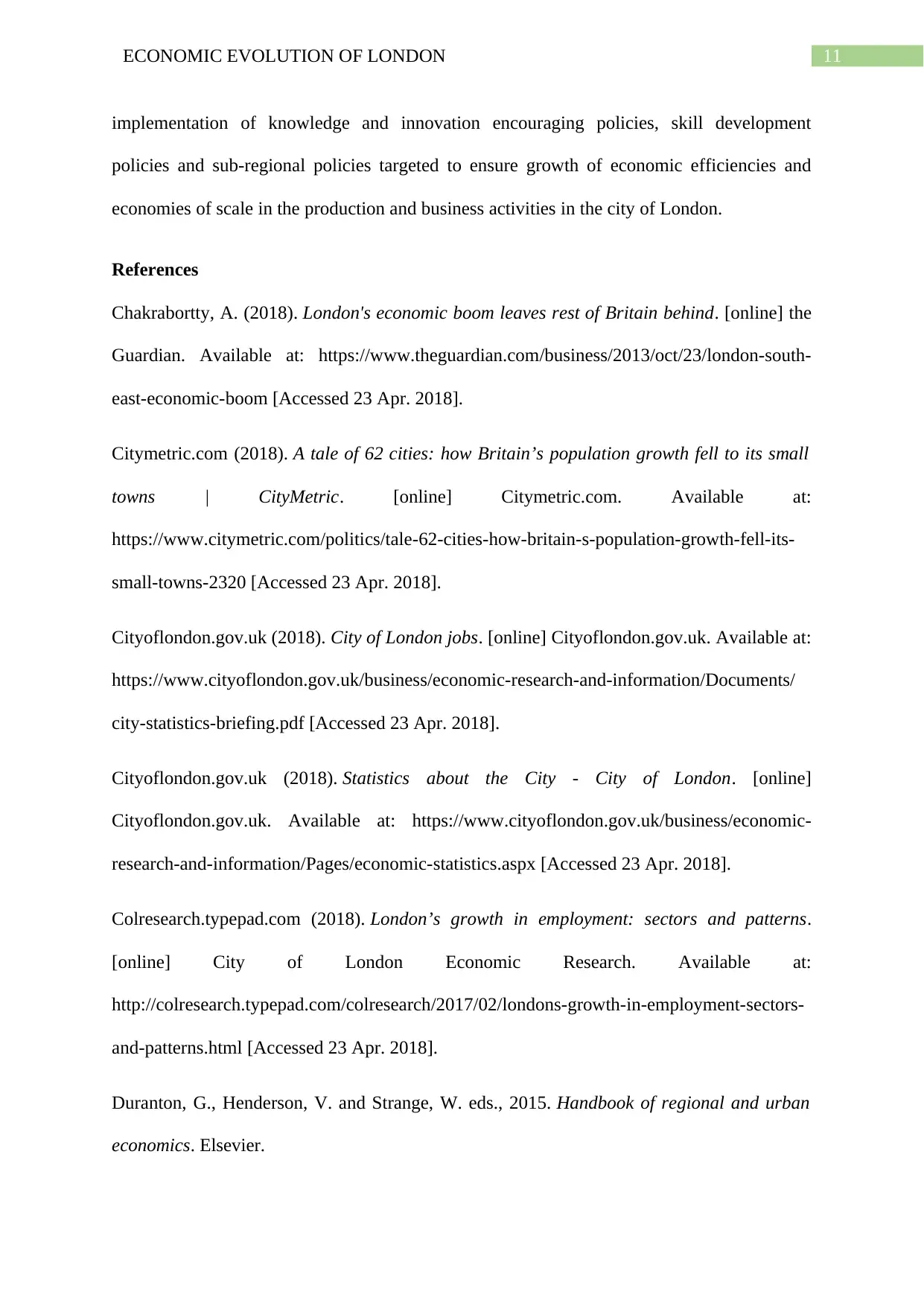
11ECONOMIC EVOLUTION OF LONDON
implementation of knowledge and innovation encouraging policies, skill development
policies and sub-regional policies targeted to ensure growth of economic efficiencies and
economies of scale in the production and business activities in the city of London.
References
Chakrabortty, A. (2018). London's economic boom leaves rest of Britain behind. [online] the
Guardian. Available at: https://www.theguardian.com/business/2013/oct/23/london-south-
east-economic-boom [Accessed 23 Apr. 2018].
Citymetric.com (2018). A tale of 62 cities: how Britain’s population growth fell to its small
towns | CityMetric. [online] Citymetric.com. Available at:
https://www.citymetric.com/politics/tale-62-cities-how-britain-s-population-growth-fell-its-
small-towns-2320 [Accessed 23 Apr. 2018].
Cityoflondon.gov.uk (2018). City of London jobs. [online] Cityoflondon.gov.uk. Available at:
https://www.cityoflondon.gov.uk/business/economic-research-and-information/Documents/
city-statistics-briefing.pdf [Accessed 23 Apr. 2018].
Cityoflondon.gov.uk (2018). Statistics about the City - City of London. [online]
Cityoflondon.gov.uk. Available at: https://www.cityoflondon.gov.uk/business/economic-
research-and-information/Pages/economic-statistics.aspx [Accessed 23 Apr. 2018].
Colresearch.typepad.com (2018). London’s growth in employment: sectors and patterns.
[online] City of London Economic Research. Available at:
http://colresearch.typepad.com/colresearch/2017/02/londons-growth-in-employment-sectors-
and-patterns.html [Accessed 23 Apr. 2018].
Duranton, G., Henderson, V. and Strange, W. eds., 2015. Handbook of regional and urban
economics. Elsevier.
implementation of knowledge and innovation encouraging policies, skill development
policies and sub-regional policies targeted to ensure growth of economic efficiencies and
economies of scale in the production and business activities in the city of London.
References
Chakrabortty, A. (2018). London's economic boom leaves rest of Britain behind. [online] the
Guardian. Available at: https://www.theguardian.com/business/2013/oct/23/london-south-
east-economic-boom [Accessed 23 Apr. 2018].
Citymetric.com (2018). A tale of 62 cities: how Britain’s population growth fell to its small
towns | CityMetric. [online] Citymetric.com. Available at:
https://www.citymetric.com/politics/tale-62-cities-how-britain-s-population-growth-fell-its-
small-towns-2320 [Accessed 23 Apr. 2018].
Cityoflondon.gov.uk (2018). City of London jobs. [online] Cityoflondon.gov.uk. Available at:
https://www.cityoflondon.gov.uk/business/economic-research-and-information/Documents/
city-statistics-briefing.pdf [Accessed 23 Apr. 2018].
Cityoflondon.gov.uk (2018). Statistics about the City - City of London. [online]
Cityoflondon.gov.uk. Available at: https://www.cityoflondon.gov.uk/business/economic-
research-and-information/Pages/economic-statistics.aspx [Accessed 23 Apr. 2018].
Colresearch.typepad.com (2018). London’s growth in employment: sectors and patterns.
[online] City of London Economic Research. Available at:
http://colresearch.typepad.com/colresearch/2017/02/londons-growth-in-employment-sectors-
and-patterns.html [Accessed 23 Apr. 2018].
Duranton, G., Henderson, V. and Strange, W. eds., 2015. Handbook of regional and urban
economics. Elsevier.
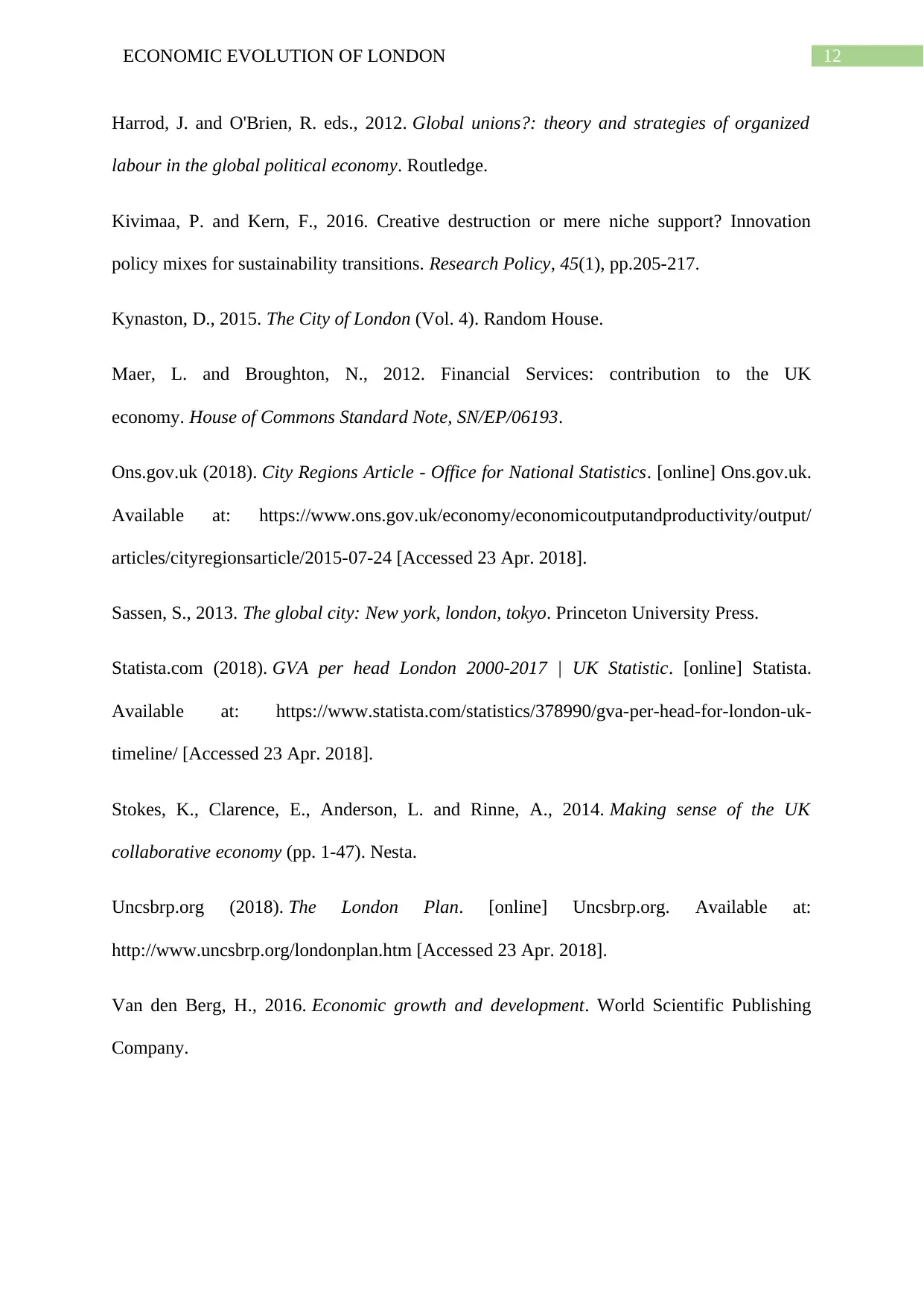
12ECONOMIC EVOLUTION OF LONDON
Harrod, J. and O'Brien, R. eds., 2012. Global unions?: theory and strategies of organized
labour in the global political economy. Routledge.
Kivimaa, P. and Kern, F., 2016. Creative destruction or mere niche support? Innovation
policy mixes for sustainability transitions. Research Policy, 45(1), pp.205-217.
Kynaston, D., 2015. The City of London (Vol. 4). Random House.
Maer, L. and Broughton, N., 2012. Financial Services: contribution to the UK
economy. House of Commons Standard Note, SN/EP/06193.
Ons.gov.uk (2018). City Regions Article - Office for National Statistics. [online] Ons.gov.uk.
Available at: https://www.ons.gov.uk/economy/economicoutputandproductivity/output/
articles/cityregionsarticle/2015-07-24 [Accessed 23 Apr. 2018].
Sassen, S., 2013. The global city: New york, london, tokyo. Princeton University Press.
Statista.com (2018). GVA per head London 2000-2017 | UK Statistic. [online] Statista.
Available at: https://www.statista.com/statistics/378990/gva-per-head-for-london-uk-
timeline/ [Accessed 23 Apr. 2018].
Stokes, K., Clarence, E., Anderson, L. and Rinne, A., 2014. Making sense of the UK
collaborative economy (pp. 1-47). Nesta.
Uncsbrp.org (2018). The London Plan. [online] Uncsbrp.org. Available at:
http://www.uncsbrp.org/londonplan.htm [Accessed 23 Apr. 2018].
Van den Berg, H., 2016. Economic growth and development. World Scientific Publishing
Company.
Harrod, J. and O'Brien, R. eds., 2012. Global unions?: theory and strategies of organized
labour in the global political economy. Routledge.
Kivimaa, P. and Kern, F., 2016. Creative destruction or mere niche support? Innovation
policy mixes for sustainability transitions. Research Policy, 45(1), pp.205-217.
Kynaston, D., 2015. The City of London (Vol. 4). Random House.
Maer, L. and Broughton, N., 2012. Financial Services: contribution to the UK
economy. House of Commons Standard Note, SN/EP/06193.
Ons.gov.uk (2018). City Regions Article - Office for National Statistics. [online] Ons.gov.uk.
Available at: https://www.ons.gov.uk/economy/economicoutputandproductivity/output/
articles/cityregionsarticle/2015-07-24 [Accessed 23 Apr. 2018].
Sassen, S., 2013. The global city: New york, london, tokyo. Princeton University Press.
Statista.com (2018). GVA per head London 2000-2017 | UK Statistic. [online] Statista.
Available at: https://www.statista.com/statistics/378990/gva-per-head-for-london-uk-
timeline/ [Accessed 23 Apr. 2018].
Stokes, K., Clarence, E., Anderson, L. and Rinne, A., 2014. Making sense of the UK
collaborative economy (pp. 1-47). Nesta.
Uncsbrp.org (2018). The London Plan. [online] Uncsbrp.org. Available at:
http://www.uncsbrp.org/londonplan.htm [Accessed 23 Apr. 2018].
Van den Berg, H., 2016. Economic growth and development. World Scientific Publishing
Company.
1 out of 13
Related Documents
Your All-in-One AI-Powered Toolkit for Academic Success.
+13062052269
info@desklib.com
Available 24*7 on WhatsApp / Email
![[object Object]](/_next/static/media/star-bottom.7253800d.svg)
Unlock your academic potential
© 2024 | Zucol Services PVT LTD | All rights reserved.





